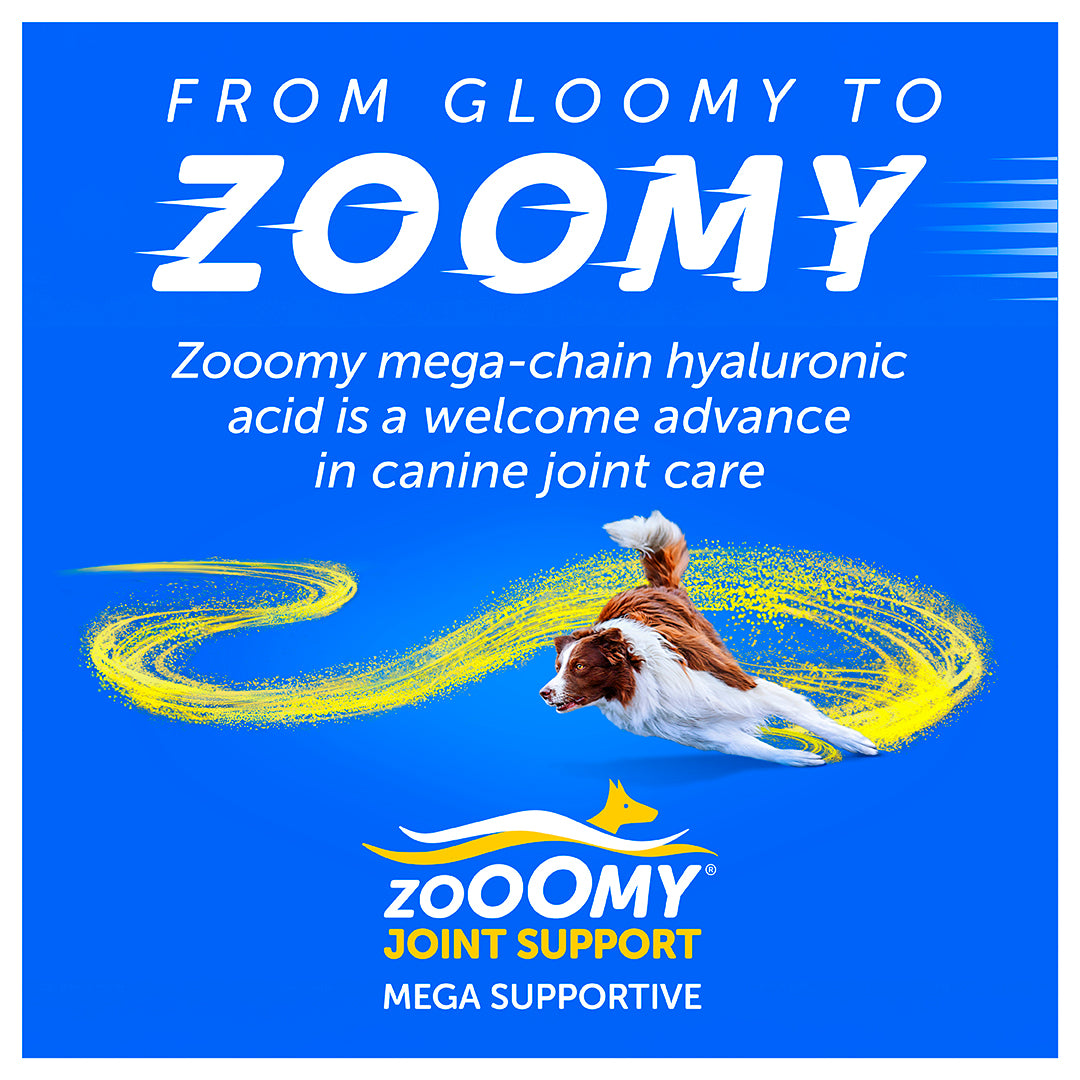If your dog has been diagnosed with arthritis, you might be feeling overwhelmed by the sheer number of medications, supplements, and therapies available.
What do they all do? Which ones actually help? And what are the risks?
This guide, created by our vet Humphrey, breaks down your treatment options for arthritis clearly and simply. Let’s get stuck in!
Veterinary Arthritis Medicines for Dogs
Veterinary treatment for arthritis usually starts with pain management. Most vets will prescribe non-steroidal anti-inflammatory drugs (NSAIDs). In some cases, additional or alternative pain-relieving medications are needed.
Here's a breakdown of the most common options.
NSAIDs (Non-Steroidal Anti-Inflammatory Drugs)
Meloxicam (Metacam, Rheumocam, Loxicom etc)
The most commonly prescribed NSAID for dogs in the UK. It reduces inflammation and pain, and helps slow the cycle of joint cartilage breakdown. Available as a liquid, it’s easy to add to food.
Potential side effects: gastrointestinal upset, reduced appetite, vomiting, diarrhoea, kidney or liver issues with long-term use. Vets sometimes recommend blood tests to monitor a dog's health.
Carprofen (Rimadyl, Norocarp etc)
Another first-generation NSAID, available in tablets or chewables. Similar benefits and risks to Metacam.
Grapiprant (Galliprant)
A newer type of NSAID targeting a specific receptor involved in joint pain. It’s often used when traditional NSAIDs can’t be tolerated.
Potential side effects: less risk of kidney/liver problems, but gastrointestinal upset still possible.
Enflicoxib (Daxocox)
A newer weekly tablet option - convenient for owners who struggle to medicate daily.
Potential side effects: similar to other NSAIDs.

Other Pain Relievers
Pardale-V (paracetamol + codeine)
Licensed for use in dogs in the UK. Often used as well as other medicines for example, when NSAIDs aren’t enough.
Potential side effects: liver stress, especially if dosed incorrectly. Always stick closely to veterinary instructions.
Gabapentin
Originally an epilepsy drug, now often used off-licence in dogs for "nerve pain" and chronic pain support.
Potential side effects: sedation, wobbliness.
Amantadine
Another off-licence medication often added as a second-line treatment. Enhances the effects of other painkillers.
Potential side effects: gastrointestinal upset, restlessness.
Tramadol (Tralieve)
A weak opioid painkiller licensed for dogs. Sometimes prescribed, but evidence of its effectiveness in dogs is mixed.
Potential side effects: sedation, nausea, constipation.

Injectable Medicines
Librela (bedinvetmab)
A monthly injection that blocks "nerve growth factor" to reduce arthritis pain.
Potential side effects: occasional reports of bladder and liver issues. It's powerful, but isn't used as a first-line treatment.
Cartrophen (pentosan polysulfate sodium)
An injectable medication given once weekly for four weeks. It aims to protect and support the joint structures rather than just masking pain.
Potential side effects: generally low risk.
Injectable Hyaluronic Acid
Hyaluronic acid can be injected directly into joints (intra-articular) or into veins (intravenous).
Examples:
-
Hylartil Vet (intra-articular)
-
Hyonate (intravenous)
Injectable HA improves joint lubrication and reduces inflammation. It's licensed for veterinary use and has proven benefits - but requires vet administration and isn't commonly offered for dogs.
A cheaper and more accessible alternative is oral hyaluronic acid for dogs. We make Zooomy using long chain HA, the same stuff used in injectable treatments, and the only kind of HA proven to be absorbed in dogs.
Joint Supplements
There are a lot of joint supplements on the market, but many of the ingredients have very weak data to evidence their effectiveness. However, supplements can play a helpful complementary role alongside prescribed medicines.
Here’s a breakdown of the common types available:
Hyaluronic Acid:
Supports joint lubrication. Absorption depends on the type; Zooomy uses long chain HA for proven uptake. Studies have proven the effectiveness of long chain hyaluronic acid in human knee arthritis and HA absorption in dogs.
Collagen:
A key building block of cartilage.Studies have shown that undenatured type II collagen (UC-II) and collagen hydrolysates may have some benefit for dogs with arthritis.
Green Lipped Mussel:
Contains anti-inflammatory omega-3s; there’s some evidence for benefits. Dogs with shellfish allergies shouldn’t take this supplement.
Omega 3 Fatty Acids:
Help reduce inflammation overall.
Chondroitin & Glucosamine:
Popular, but evidence for effectiveness is patchy and mixed.
Boswellia:
A plant extract thought to have anti-inflammatory properties. Again, not a lot of evidence for its effects.
It’s very easy to spend a fortune on supplements for your arthritic dog, in desperate hope of providing some relief.
Understanding the ingredients and the evidence behind the supplements you choose is important - both so you can ensure you only spend on things that have an evidence base and to avoid adverse effects in your dog through contraindications.
Learn more about how to choose a joint supplement for your dog here.
Complementary Therapies
-
Hydrotherapy: Controlled swimming to strengthen muscles and reduce strain on joints.
-
Physiotherapy: Tailored exercises to improve movement and comfort.
-
Galen Myotherapy: Massage therapy focused on chronic muscular pain.
-
Laser Therapy: Helps stimulate cell repair and reduce inflammation.
-
Heat Therapy: Heat pads and infrared tools like the Photizo promote circulation.
Home and Lifestyle Adjustments
Making your dog’s environment more arthritis-friendly is crucial as it can reduce impact on your dog’s joints and improve their comfort levels.
Here are some simple, practical changes you can make:
-
Provide supportive, orthopedic bedding
-
Use non-slip mats on slippery floors
-
Offer shorter, more frequent walks
-
Maintain a healthy weight
-
Use ramps instead of stairs when possible
-
Keep them warm, especially in colder months
-
Trim nails regularly to prevent joint stress
-
Massage sore muscles gently
Read more on 10 top ways to help your dog with arthritis at home here.
Final Thoughts
Managing arthritis is about more than just masking pain - it’s about protecting your dog’s joints, maintaining their mobility, and giving them the best quality of life possible.
Zooomy (our rapidly-absorbed, vet-developed hyaluronic acid supplement) fits naturally alongside medicines, therapies, and home changes - helping you build a complete, thoughtful care plan for your dog.
If you’re ever unsure about the best approach for your individual dog, please speak to your vet.
And remember, small changes can make a big difference.
Read Next:
Using Hyaluronic Acid Supplements for Managing Arthritis in Dogs
How to choose a joint supplement for your dog?
Hyaluronic acid: why long chain is better than short chain
How does hyaluronic acid work?



